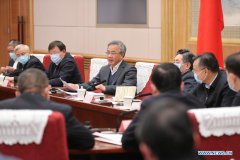Home>>
Stories of High-Quality Development | Delivering good results for coordinated regional developmentBy Li Qiaochu (People's Daily Online) 10:22, May 29, 2025
Regions serve as key platforms for the country to allocate resources, plan industrial layouts, and organize economic activities. China is a vast and populous country with remarkable differences in natural resource endowment among its various regions, and there are disparities in development foundations across regions. Therefore, promoting coordinated regional development has always been a major challenge, and it is an essential requirement for economic prosperity.
China's economy has shifted from a period of rapid growth to one of high-quality development, placing new demands on coordinated regional development, said Hou Yongzhi, former director-general of the Development Strategy and Regional Economy Department at the Development Research Center of the State Council, during "Stories of High-Quality Development," a People's Daily video series.
Coordinated regional development should not simply mean requiring all regions to reach the same economic level, Hou said. Instead, the country must follow a path of appropriate division of labor, complementarity, and high-quality development.
Central, local governments jointly draw up blueprint for coordinated regional development
"When people move to a different city for work and life, will their salary remain the same? What about their children's education? Can the medical resources keep up?" These cross-provincial livelihood concerns are widely shared by the public. How can these problems be solved?
"Before I decided to leave Beijing for the neighboring Xiong'an New Area, my family and friends urged me to think carefully, because they worried that in Xiong'an, I might not enjoy the same benefits as in the capital city of Beijing. However, after I arrived in Xiong'an, I found that my social security was seamlessly transferred, and my housing provident fund was quickly recognized across regions. I went from commuting across regions to living in the same urban area where I worked, making balancing both family and work much easier, which feels really great," said Song Fazhi, product manager of China Mobile Xiong'an Information & Communication Technology Co., Ltd.
"During the coordinated advancement of the Xiong'an New Area across the Beijing-Tianjin-Hebei region, we worked on the public welfare and livelihood guarantees and the overall planning in parallel. Under the central government's guidance, Beijing, Tianjin and Hebei have implemented cross-regional policy coordination, service sharing, and resource allocation to ensure that relocated organizations and personnel can enjoy 'move-in readiness,' and settle seamlessly, stay sustainably, and thrive assuredly in Xiong'an," said Liu Jia, deputy director of the Reform and Development Bureau of Xiong'an New Area.
Liu added that the successive release of documents closely related to the coordinated development of the Beijing-Tianjin-Hebei region has convinced more and more people like Song Fazhi to put down roots in new places.
To achieve high-quality development in a single region, we must properly handle the relationship between the central government and local governments. While embracing major strategies for regional development, regions should discard a silo mentality, embrace a mindset that treats the nation as one integrated whole, and identify the local region's role and mission within the national strategy for coordinated regional development and major regional strategies. They should actively serve and integrate into national development. With major regions moving forward together, we can create a more balanced and coordinated development pattern and expand the space for domestic circulation, achieving greater progress in pursuing high-quality development, Hou noted.
Complementary advantages among regions enhance industrial efficiency
River systems and mountains serve as ecological corridors for the reproduction and survival of organisms. They are not restricted by administrative divisions and need to be protected by neighboring provinces.
"People who grow up by the river have a special connection to the Yangtze River. Since I was a child, my father told me that every plant and tree along the riverbank, and every fish and shrimp in the water, are gifts bestowed upon us by this mother river. Safeguarding the Yangtze River is a seed planted in my heart by my elders," said Cheng Wei, a member of the Ma'anshan Fishery Administrative Law Enforcement Detachment in Anhui province.
How can the three cities break through regional limitations and jointly protect the Yangtze finless porpoises throughout their entire life cycle?
On Oct. 24, 2022, Ma'anshan city collaborated with Nanjing and Zhenjiang cities in Jiangsu Province to formulate a decision on strengthening protection of the Yangtze finless porpoises.
"With the common goal of protecting finless porpoises and building an ecological civilization, our three cities have worked closely together, and the fishery law enforcement departments have also transformed from peers into a family. Now, the scale and density of fish resources in the Ma'anshan section of the Yangtze River have reached 1.5 times and 2 times their pre-fishing-ban levels, respectively. Rare aquatic creatures, including the Yangtze finless porpoises, are frequently appearing," said Cheng. Safeguarding the "smiles" of the finless porpoises is not only about protecting the Yangtze River, but also about safeguarding the future of high-quality regional development.








